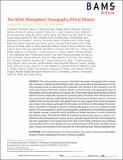THE NASA ATMOSPHERIC TOMOGRAPHY (ATom) MISSION: Imaging the Chemistry of the Global Atmosphere
Author(s)
Fiore, Arlene
DownloadPublished version (81.26Mb)
Publisher Policy
Publisher Policy
Article is made available in accordance with the publisher's policy and may be subject to US copyright law. Please refer to the publisher's site for terms of use.
Terms of use
Metadata
Show full item recordAbstract
<jats:title>Abstract</jats:title>
<jats:p>This article provides an overview of the NASA Atmospheric Tomography (ATom) mission and a summary of selected scientific findings to date. ATom was an airborne measurements and modeling campaign aimed at characterizing the composition and chemistry of the troposphere over the most remote regions of the Pacific, Southern, Atlantic, and Arctic Oceans, and examining the impact of anthropogenic and natural emissions on a global scale. These remote regions dominate global chemical reactivity and are exceptionally important for global air quality and climate. ATom data provide the in situ measurements needed to understand the range of chemical species and their reactions, and to test satellite remote sensing observations and global models over large regions of the remote atmosphere. Lack of data in these regions, particularly over the oceans, has limited our understanding of how atmospheric composition is changing in response to shifting anthropogenic emissions and physical climate change. ATom was designed as a global-scale tomographic sampling mission with extensive geographic and seasonal coverage, tropospheric vertical profiling, and detailed speciation of reactive compounds and pollution tracers. ATom flew the NASA DC-8 research aircraft over four seasons to collect a comprehensive suite of measurements of gases, aerosols, and radical species from the remote troposphere and lower stratosphere on four global circuits from 2016 to 2018. Flights maintained near-continuous vertical profiling of 0.15–13-km altitudes on long meridional transects of the Pacific and Atlantic Ocean basins. Analysis and modeling of ATom data have led to the significant early findings highlighted here.</jats:p>
Date issued
2022Department
Massachusetts Institute of Technology. Department of Earth, Atmospheric, and Planetary SciencesJournal
Bulletin of the American Meteorological Society
Publisher
American Meteorological Society
Citation
Fiore, Arlene. 2022. "THE NASA ATMOSPHERIC TOMOGRAPHY (ATom) MISSION: Imaging the Chemistry of the Global Atmosphere." Bulletin of the American Meteorological Society, 103 (3).
Version: Final published version